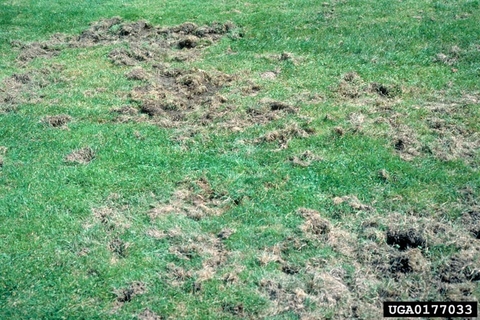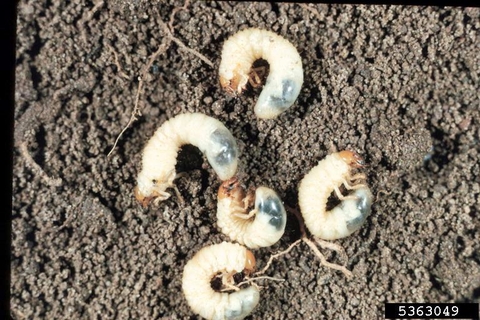In some Minnesota lawns, instead of the grass greening up, the grass is being torn up. People are reporting lawns ripped up by raccoons, moles or crows. These hungry animals are just a symptom of the lawn’s actual problem: white grubs.
So, what’s going on?
“White grubs” are what we call the larvae of several beetles. Japanese beetle is the flashiest one grabbing the most attention, but rose chafer and May-June beetles also look very similar when they aren’t fully grown.
White grubs spend the winter buried deep in the soil to protect them from extreme winter temperatures. Now that Minnesota is warming up, the grubs are climbing to the top few inches of the soil. Here, they will feed on grass roots. Homeowners can even roll up their dying lawn like a carpet if the feeding becomes bad.
Many species of grubs are relatively big (an inch in size), and their populations can be very high (a dozen grubs per square foot). With populations like that, these grubs are a tempting treat for crows, moles and raccoons, that are responsible for some of the digging people are seeing in Minnesota lawns.
What to do this spring
Figure out what you’re dealing with
Identifying what species of white grubs you have is important if you want to do something about them. Each species has a slightly different life cycle, so treatment options and timing are different.
For information on identifying white grubs, see Managing white grubs in turfgrass from Purdue University.
Do what you can to repair and keep grass healthy
If your lawn has been torn up, your first instinct might be to spray grubs and trap the animals trying to eat them. This time of year, that is not the right approach.
Instead, focus on repairing damage and giving turf what it needs to be healthy.
For more information on lawn renovation, see Renovating a lawn for quality and sustainability.
Keep the pesticides in the shed
There are products, both organic and conventional, advertised for white grubs. But spring is the wrong time to apply them, even if you see damage.
For many Minnesota lawns, it is likely that Japanese beetle grubs are causing the damage. This species of large grubs is only feeding for a few more weeks. Unfortunately, these insects are large enough that they are fairly resistant to pesticides. Later in the summer is a better time to treat. Hitting the pests then will help avoid damage to lawns next spring.
While you may be tempted to spray something on your lawn, that probably will not stop adult Japanese beetles from attacking your garden or trees. Japanese beetles are mobile once they get wings.
When the grubs currently in your yard become adults, they might hang out in your yard or they could fly a few blocks away. You might be able to stop that with treatment. But what is stopping the Japanese beetles from your neighbor’s yard from laying eggs on your lawn? Or the golf course a half a mile away?
Unfortunately, because the adult beetles are so mobile, treating grubs now does not mean you won’t see any adults in your landscaping or garden, and it does not mean you won’t have grubs feeding on your lawn later this summer.
Make a plan for later this summer
White grubs can turn into a recurring problem in some spots. If you have been seeing the grub damage over consecutive years, mid-to-late summer is the best treatment window.
For more information on how to manage this pest, see our Japanese beetle page.




